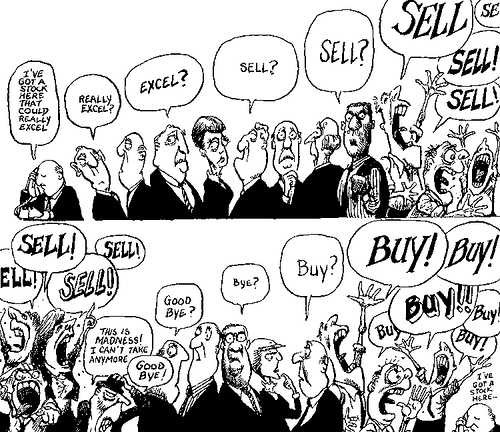Behavioral Finance
Post on: 18 Апрель, 2015 No Comment

Human nature often compromises investment returns.
Introduction to Behavioral Finance
We frequently talk about efficient markets, risk management, asset class diversification and other topics of modern finance. These and other principles assume that investors make rational choices with their money. While rational behavior appears to rule in the aggregate (i.e. entire stock markets), it often falters at the individual level. Truly, many investors act on impulse, emotion and illusion and pay a high price for their mistakes.
We have found that the easiest way to avoid these mistakes is to create an investment plan. The investment plan helps instill discipline regardless of short-term market movements. And without commitment and discipline, even the best designed portfolio is doomed to collapse under the weight of an owners fears, doubts and emotional swings triggered by market fluctuations.
Worse yet, an investor who walks away from a structured portfolio must walk toward something else. That something else is rarely based on sound methodology. When investors act on impulse, they fall prey to market myths, false hopes and financial illusions. If mental discipline is this crucial, we should strive to understand why investors are tempted to abandon their long-term plan.
Theres a relatively new academic field that can offer insight and wisdom. Known as Behavioral Finance, it explores the role of human psychology in financial decision making. The research offers a compelling view of how and why people make financial mistakes.
Researchers form theories about the role of social behavior, human emotion and cognitive bias on financial decision making.(1) Behavioral finance applies both hard and soft science to theories of how people interpret information and act on it. Hard science methods include experimentation, factual observation and quantitative analysis. Soft science relies on qualitative research and subjective tools of economics, psychology and other social sciences.
History of Behavioral Finance
Since its advent three decades ago, behavioral finance has challenged traditional economic models that assume investors make rational, unbiased decisions about their money.
Research in behavioral finance entered the mainstream in 1979 when Daniel Kahneman and Amos Tversky published a foundational paper on prospect theory. They found that, contrary to prevailing economic theory, investors do not act consistently when facing gains and losses. In general, people are much more distressed by prospective losses than they are gratified by investment gains. This leads individuals to take higher risks to avoid losses while becoming risk averse when gains are involved. The professors also found that the way in which a proposal is framed (i.e. as a gain or loss) affects choice. Kahneman was awarded the Nobel Prize in 2002 for his work in behavioral finance and economics.
Early theories in behavioral finance developed from observed experiments and survey responses. Academics now use quantitative analysis of financial data to form theories about investment psychology and market behavior. Other prominent experts in the field include Meir Statman, Richard Thaler, Robert Shiller, Hersh Shefrin, Terrance Odean and Brad Barber, to name a few.
Most behavioral finance research delves into one of three main areas: heuristics, framing or market effect. Heuristics deals with decisions influenced by mental rules-of-thumb and various forms of cognitive bias. Framing studies how the description of a problem affects decisions. Market effect includes research into why markets sometimes appear to reflect anomalies, mispricing and other inefficiencies.
Common Mistakes Identified by Behavioral Finance
The following introduces some of the more common investment errors identified in research. These include:
- Mental accounting: This refers to peoples tendency to partition their finances into categories. One example of mental accounting is when a retiree separates his portfolio into safe and risky categories, with the safe investments designed for principal protection and the aggressive investments intended for growth. The approach often results in higher risk from over-concentration in a single stock, sector or asset group—and higher expenses and taxes due to inefficient portfolio management.The risk-return tradeoff is better managed at the portfolio level using the principles of Modern Portfolio Theory (MPT), which center upon a portfolios overall risk and return traits rather than the performance of the individual components.(2) This results in more efficient mixing of assets and reduction of total risk for a given expected return—or an optimally higher expected return for a given risk level.
- Availability bias: This refers to how people use familiar events and information to assess the probability of a future outcome.(3) Rather than thoroughly researching a topic and weighing the information objectively, people turn to the most accessible and convenient sources for guidance. This is one reason why investment companies spend millions on advertising the track records of a few high-performing mutual funds within their entire fund family. They are betting that many consumers will choose funds according to name recognition or assume that perceived success in one sector or style infers equivalent skill in other fund categories.You can avoid this bias by following accurate research that is presented scientifically and in context by objective sources, including legitimate academic institutions and researchers, as well as certain professional and academic journals.
- Anchoring bias: When estimating probabilities, individuals anchor on a specific value and then adjust it to account for other elements of the circumstance. Usually once the anchor is set, there is a bias toward that value. For instance, even the most prudent investors may anchor their overall return expectations to the U.S. stock markets long-term average, as defined by the S&P 500 or Wilshire 5000 indexes. When the market drastically deviates from the particular average, investors begin to question whether the nature of markets has changed. (Remember the technology stock bubble in 1999?) After a prolonged period of abnormal returns, some investors begin adjusting their long-term views to match recent experience, despite the fact that even a prolonged period of variance is not unusual. This illustrates recency bias, which is the opposite of anchoring. People can give too much weight to recent experience and extrapolate recent trends that are at odds with long-term averages.The remedy to both anchoring and recency bias is to adapt a statistical view of the long term and to use the most appropriate benchmarks when assessing performance or comparing specific investments.
- Confirmation bias: Investors tend to seek out and interpret information in a way that confirms what they want to believe. Moreover, they reject or downplay information that challenges their opinion. Investment firms may play to this weakness by highlighting certain research to support their positions while ignoring conflicting evidence.Strains of confirmation bias also circulate through the financial media. For example, pundits refer to the markets price-earnings (P/E) ratio to predict the markets future direction. When the ratio moves above the long-term average, they warn that the market is overvalued; when the P/E is below the average, they predict that the market is poised for an advance.

This view is based on selective use of data. Academic research does not provide convincing evidence that the markets average P/E can reliably predict the direction of stock prices.(4)
Practical Application of Behavioral Finance
These are only a few of many cognitive errors affecting investment decision making. You can avoid them by understanding how markets work and striving to stay informed of major academic developments in finance. Most of the leading-edge investment tools and investments we apply in portfolio management are products of this body of knowledge. Accurate knowledge encourages discipline—and discipline helps you stay invested through various economic environments. Thats how we build long-term wealth through the financial markets.
Notes
en.wikipedia.org/wiki/Behavioral_finance )
(2) MPT proposes that optimal diversified stock portfolios exist, with each portfolio offering the highest expected return for a given level of risk. The strategy proposes diversification among lower-correlation stocks and asset groups. This results in more efficient mixing of assets and reduction of total risk for a given expected return—or an optimally higher expected return for a given risk level.
en.wikipedia.org/wiki/Availability_heuristic )
(4) Based on analysis of average P/E ratios for the S&P 500, measured over 275 quarters between 1936 and 2005. (Meir Statman, Confirmation Bias, Cognitive Bias Series, The Monitor) www.imca.org
(5) To rebalance, you sell overweighted assets and acquire underweighted assets. Returning to the target allocation reinstates your investment policy and helps you better manage market uncertainty. It also encourages dispassionate decision making that result in the acquisition of assets that are declining in value and the sale of assets that are rising in value.
faculty.haas.berkeley.edu/odean/ ) Barber and Odean have specialized in the trading behavior of individual investors. They researched the returns of tens of thousands of households with accounts at a large discount brokerage firm during the late 1980s and most of the 1990s.














